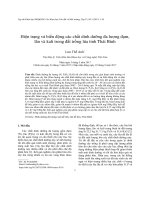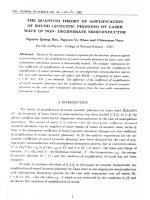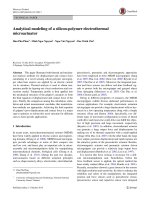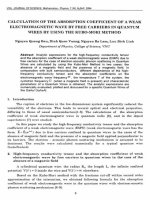DSpace at VNU: The impact of confined phonons on the nonlinear absorption coefficient of a strong electromagnetic wave by confined electrons in compositional superlattices
Bạn đang xem bản rút gọn của tài liệu. Xem và tải ngay bản đầy đủ của tài liệu tại đây (242.58 KB, 9 trang )
VNU Journal of Science, Mathematics - Physics 28 (2012) 68-76
The impact of confined phonons on the nonlinear absorption
coefficient of a strong electromagnetic wave by confined
electrons in compositional superlattices
Le Thai Hung*, Nguyen Vu Nhan, Nguyen Quang Bau
1
Faculty of Physics, VNU University of Science, 334 Nguyen Trai, Hanoi, Vietnam
Received 16 April 2011, received in revised from 22 May 2012
Abstract. The impact of confined phonons on the nonlinear absorption coefficient (NAC) of a
strong electromagnetic wave (EMW) by confined electrons in compositional superlattices is
theoretically studied by using the quantum transport equation for electrons. The dependence of the
NAC on the energy ( Ω ), the amplitude (Eo) of external strong EMW, the temperature (T) of the
system and the period (dA) of compositional superlattices is obtained in both case of confined and
unconfined phonons. Two cases for the absorption: Close to the absorption threshold
k Ω − ωo << ε and far away from the absorption threshold k Ω − ωo >> ε ( k = 0,±1,±2... ;
ωo and ε are the energy of optical phonon and the average energy of electrons, respectively)
are considered. The analytic expressions are numerically evaluated, plotted and discussed for a
specific of the GaAs-Al0.3Ga0.7As compositional superlattices. There are more resonant peaks
appearing and the values of of the NAC are much larger than they are in case of unconfined
phonons.
1. Introduction∗
Recently, much attention has also been focused on the study of the behavior of lowdimensional system (LDS), in particular two-dimensional systems. This due to that the confinement
effect in LDS considerably enhances the electron and phonon mobility and leads to unusual behaviors
under external stimuli. Many papers have appeared dealing with these behaviors, for examples,
electron-phonon interaction and scattering rates [1-3] and dc electrical conductivity [4, 5]. The
problems of the absorption coefficient for a weak EMW in some two-dimensional systems [6-9] have
also been investigated by using Kubo-Mori method. The NAC of free electrons in normal bulk
semiconductors [10] and confined electrons in quantum wells [11], in doped superlattices [12] have
been studied by quantum kinetic equation method. The influences of confined phonons on the NAC of
_______
∗
Corresponding author. Tel.: 84- 904328279
E-mail:
68
69
L.T. Hung et al. / VNU Journal of Science, Mathematics-Physics 28 (2012) 68-76
a strong EMW in the quantum wells and the doped superlatices [13, 14], on the electron interaction
with acoustic phonons in the CQW vie deformation potential [15] are considered.
However, the NAC of a strong EMW, whose strong intensity and high frequency in compositional
superlattices with confined phonons is opened for study. So in this paper, we study the NAC of a
strong EMW by confined electrons in compositional superlattices with the influence of confined
phonons. Then, we estimate numerical values for a specific case of the GaAs-Al0.3Ga0.7As
compositional superlattices to clarify our results.
2. Nolinear absorption coeficient in case of confined phonons
The Hamiltonian of the electron-optical phonon system in the second quantization representation
can be written as:
H = H o +U
(1)
e
H o = ∑ ε n k ⊥ − A ( t ) a n+,k a n ,k + ∑ ω o bm+,q bm ,q
⊥
⊥
c
⊥ ⊥ m ,q⊥
n ,k ⊥
(2)
U =
∑ ∑C
m ,q ⊥
(
I nnm 'a n+',k +q a n ,k bm ,q + bm+,q
⊥
⊥
⊥
)
(3)
m ,q ⊥ k ⊥ ,n ,n '
where Ho is the non-interaction Hamiltonian of the electron-phonon system, n (n = 1, 2, 3, ...)
ρ
ρ
ρ
denotes thes quantization of the energy spectrum in the z direction, ( n, k ⊥ ) and ( n' , k ⊥ + q ⊥ ) are
ρ ρ
electron states before and after scattering, respectively k ⊥ ( q ⊥ ) is the in plane (x, y) wave vector of
+
+
the electron (phonon), a n, kρ , a n ,kρ ( bm ,qρ⊥ , bm ,qρ⊥ ) are the creation and the annihilation operators of
⊥
⊥
ρ
electron (phonon), respectively, A(t ) is the vector potential of an extenrnal EMW A (t ) =
e
E sin Ωt
Ω o
( )
and ωo is the energy of a free optical phonon.
It is well known that in the low-dimensional structures, the energy levels of the electron become
discrete in the confined direction, which are different between different dimensionalities. In this paper,
we assume that the quantization direction is the z direction and only consider intersubband transitions
(n≠n’) and intrasubband transitions (n=n '). In this system, the electron-optical phonon interaction
constants C m ,q , the electron energy ε n ,k and the electron form factor I nm,n ' can be written as [16]:
⊥
⊥
2
C m ,q
⊥
2π e ωo 1
1 1
=
− 2
εoV χ ∞ χ o q⊥ + q z2
2
Sod
I nm,n ' =
∫ψ
0
∗
n
( z )ψ n ' ( z )e
iq z z
dz
; q z = m π ; m = 1,2,3...
L
(4)
(5)
70
L.T. Hung et al. / VNU Journal of Science, Mathematics-Physics 28 (2012) 68-76
2
ε n ,k = εn +
⊥
k ⊥2
− ∆ n cos k //n d
∗
2m
(6)
Here, V and εo are the normalization volume and the electron constant, χo and χ∞ are the static and
the high frequency dielectric constants, m ∗ and e are the effective mass and the charge of the electron,
respectively. ψn ( z ) is the wave function of the n-th state in one of the one-dimensional potential wells
which compose the superlattices potential, d is the superlattices period, So is the number of
superlattices period, ε n and ∆ n are the energy levels of an individual well and the width of the n-th
miniband, which is determined by the superlattices parameters.
In oder to establish the quantum kinetic equations for the electrons in compositional superlattices
with case of confined phonons, we use general quantum eaquation for electrons distribution function
n n ,k = a n+,ka n ,k [6,10]:
⊥
⊥
⊥
t
i
Where ψ
t
∂n∂t
n ,k ⊥
= a n+,ka n ,k, H
⊥
⊥
(7)
t
denotes a statitical average value at the moment t and ψ
∧ ∧
t
∧
= Tr (W ψ ) ( W being the
density matrix operator).
The carrier current density formula in compositional superlattices is taken the form:
j (t ) =
e
e
∑ (k − A (t ))nn ,k⊥
me n ,k⊥ ⊥ c
(8)
Because the motion of electrons is confined along z direction in superlattices, we only consider the
ρ
in plane (x, y) current density vector of electrons, j ⊥ (t ) . Starting from Hamiltonian (1, 2, 3) and
realizing operator algebraic calculations, we obtain the expression of n n ,kρ (t ) by solving the quantum
⊥
kinetic equations. Substituting n n ,kρ (t ) into Eq.(8), then using the electron-optical phonon interaction
⊥
potential C m ,qρ⊥ in Eq.(4) and the relation between the NAC of a strong EMW with the carrier current
ρ
density j ⊥ (t ) , we obtain the NAC in compositional superlattices:
∞
16 π 3e 2Ωk BT 1
1
− ∑ ∑
α=
εo c χ ∞ Eo2 χ ∞ χ o m ,q⊥ k =1
n ,n ',k ⊥
2
kJ k2
mπ
q +
2
⊥
L
2
I
m
n ,n '
(10)
×(n n ,k - n n ',k+q)d (ε n ',k+q - ε n ,k - ∆ n (cos k //n 'd - cos k //n d ) + wo - k Ω)
^
^
^
^
^
^
Eq. (10) is the general expression for the nonlinear absorption of a strong EMW in compositional
superlattices. In this paper, we will consider two limiting cases for the absorption, close to the
absorption threshold and far away from absorption threshold, to find out the explicit formula for the
absorption coefficient α.
L.T. Hung et al. / VNU Journal of Science, Mathematics-Physics 28 (2012) 68-76
71
2.1. The absorption far away from threshold
In this case, for the absorption of a strong EMW in compositional superlattices the condition
k Ω − ωo >> ε must be satisfied. Here, ε is the everage energy of an electron in compositional
superlattices. Finally, we have the explicit formula for the NACof a strong EMW in compositional
superlattices for the case of the absorption far away from its threshold, which is written:
α=
(
)
2
1
2
3e 2 E o2
1
− ∑ I nm,n ' ×{1+
B}
16m *Ω4
εo c χ ∞ m * 2Ω3 χ ∞ χ o m ,n ',n
2π 2e 4 no k B T
×{1− exp[−
kBT
(Ω − ωo )]}×
(11a)
2m * B 3/2
mπ
2m * B +
L
2
ξ = ω k (n '− n ) + ωo − Ω ;
Here
B=
π2 2
( n '2 − n 2 ) − ∆ n (cos p //n 'd − cos p//n d ) + ωo − Ω
2m ∗ L2
When quantum number m characterizing confined phonons reaches to zero, the expression of the
NAC for the case of absorption far away from its threshold in compositional superlattices without
influences of confined phonons can be written as:
α=
2
4π 2e 4 no k B T 1
1
− ∑ I n ,n '
* 2 3χ
εo c χ ∞ m Ω ∞ χ o m ,n ',n
π 2 (n 2 − n '2 ) 2m ∗ (Ω − ω ) 2m ∗
o
×
+
− 2 ∆ n (cos p //n 'd − cos p //n d )
2
L
(11b)
2
2 2
∗
2
2
∗
3 e E o π (n − n ' ) 2m (Ω − ω o ) 2m
n'
n
× 1+
+
− 2 ∆ n (cos p // d − cos p // d )
∗2 4
L2
32 m Ω
2π 2 n 2
× 1− exp −
+ (Ω − ω o ) − ∆ n cos p //n d
∗ 2
k B T 2m L
1/2
Here, I n ,n ' the electron form factor in case of unconfined phonons.
2.2. The absorption close to the threshold
In this case, the codition k Ω − ωo << ε is needed. Therefore, we can’t ignore the presence of the
ρ
vector k ⊥ in the formula of δ function. This also means that the caculation depends on the electron
distribution function n n ,kρ . Finally, the expression of the NAC for the case of absorption close to its
⊥
threshold is obtained:
72
L.T. Hung et al. / VNU Journal of Science, Mathematics-Physics 28 (2012) 68-76
α=
π e 4 no ( k B T ) 2 1
1
1
− ∑ I nm,n ' × (exp[
(Ω − ωo ) ] −1)
3 4 χ
kBT
2c χ ∞ Ω
∞ χ o m ,n ',n
×exp[−
×{1+
1
1 π 2 2 n '2
(
− ∆ n cos p/n/ 'd )]× exp[−
( B + B )]
∗ 2
k B T 2m L
kBT
3e 2 E o2 k B T
8 m * 2Ω 4
(1+
(12a)
1
B )}
2k B T
When quantum number m characterizing confined phonons reaches to zero, the expression of the
NAC for the case of absorption close from its threshold in compositional superlattices without
influences of confined phonons can be written as:
2
π 2e 4no ( k B T ) 1
2
1
α=
− ∑ I n ,n '
4 3
χ
χ
εo c χ ∞ Ω ∞
o m ,n ',n
1 π 2 2 (n 2 − n '2 )
×exp −
− ∆ n (cos p //n 'd − cos p //n d )
∗ 2
2m L
k B T
(12b)
2π 2 n 2
n
(Ω − ω o ) −1 × exp −
− ∆ n cos p // d
× exp
k B T 2m ∗ L2
k B T
2
2
3e E k T
1 π 2 ( n 2 − n '2 )
o B
1+
× 1+
+ (Ω − ωo ) − ∆ n (cos p //n 'd − cos p //n d )
∗ 2 4
2
L
8 m Ω k B T
3. Numerical results and discussion
In order to clarify the mechanism for the NAC of a strong EMW in compositional superlattices
with case of confined phonons, in this section, we will evaluate, plot and discuss the expression of the
NAC for the case of the GaAs-Al0.3Ga0.7As compositional superlattices. We use some results to make
the comparision with case of unconfined phonons. The parameters used in the caculations are as
follows [4,7,8,16]: χ o = 12.9, χ ∞ = 10.9, no = 1023 , ∆ n = 0.85meV ; L = 118 A o ; m = 0.067mo , mo being
the mass of a free electron, ωo = 36.25meV and Ω = 2.1014 s −1 , d A = 134.10−10 m , d B = 16.10 −10 m .
3. 1. The absorption far away from its threshold
Figures (1a-1b) shows the NAC of a strong EMW in a compositional superlattice as function of Eo
for the case of the absorption far away from its threshold in both case of confined and unconfined
phonons. The curve increases following Eo rather fastly. The value of the NAC is higher and higher
when m increases.
L.T. Hung et al. / VNU Journal of Science, Mathematics-Physics 28 (2012) 68-76
73
Fig 1a & 1b. The dependence of α on the amplitude Eo in compositional superlattices in case confined phonon
(1a) and in case unconfined phonons (1b).
In contrast with the Figures.(1a&1b), it is seen that the values of the NAC decrease following ћΩ
in figures(2a&2b). But when the temperature T of the system increases, its absorption coefficient
increases very slowly. This dependence is similar to the figures.(3a&3b) which show that the NAC
changes very slowly following the period dA of compositional superlattice.
Fig 2. The dependence of α on ћΩ in compositional superlattices in case confined phonon (2a) and in case
unconfined phonons (2b).
74
L.T. Hung et al. / VNU Journal of Science, Mathematics-Physics 28 (2012) 68-76
Fig 3a & 3b. The dependence of α on dA in compositional superlattices in case confined phonon (3a) and in
case unconfined phonons (3b).
All that figures show that the values of the NAC are much higher than these in case of unconfined
phonons, and its depends very strong on m. The results are quite similar to those in [13, 14].
3.2. The absorption close to the threshold
In this case, the dependence of the NAC α on other parameters are quite similar with case of the
absorption far away from its threshold. But, the values of the NAC are much greater than above case.
The first difference in figures (4a&ab), it is seen that the values of the NAC increase following the T
faster than above case.
Fig4a & 4b. The dependence of α on the amplitude Eo in compositional superlattices in case confined phonon
(4a) and in case unconfined phonons (4b)
Also, it is seen that the NAC depends much strongly on the energy of EMW ћΩ that there are
appearing resonant peaks. Especially, fig.5a show that there is appearing more resonant peak than case
L.T. Hung et al. / VNU Journal of Science, Mathematics-Physics 28 (2012) 68-76
75
of unconfined phonons in fig.5b. The posion of the first resonant peak is similar to its in case
unconfined phonon (fig.5b) but its value is much higher. The second ones which appears when
Ω > ωo is higher than the first ones.
Fig 5a & 5b. The dependence of α on ћΩ in compositional superlattices
in case confined phonon (5a) and in case unconfined phonons (5b)
In short, all figures show that the NAC depends strongly on quantum number m characterizing
confined phonons, it increases following m. The values of NAC in case of confined phonons much
higher than those in case unconfined phonons. The great impact of confined phonons on NAC is
expressed by the above results.
4. Conclusion
In this paper, we have theoretically studied the nonlinear absorption of a strong EMW by confined
electrons in compositional superlattices under the influences of confined phonons. We have obtained a
quantum kinetic equation for electrons in compositional superlattices. By using the tautology
approximation methods, we can solve this equation to find out the expression of electrons distribution
function. So that, we received the formulae of the NAC for two limited cases, which are far away from
the absorption threshold, Eq. (11a&11b) and close to the absorption threshold, Eq. (12a&12b). We
numerically calculated and graphed the NAC for compensated GaAs-Al0.3Ga0.7As compositional
superlattices to clarify the theoretical results. Numerical results present clearly the dependence of the
NAC on the amplitude (Eo), energy (ћΩ) of the external strong NAC, the temperature (T) of the
system, the period (dA). There are more resonant peaks of the absorption coefficient appearing and the
values of the NAC are larger than they are in case of unconfined phonons. The NAC depends strongly
on the quantum number m characterizing confined phonons. In short, the confinement of phonons in
compositional superlattices makes the nonlinear absorption of a strong NAC by confined electrons
stronger.
76
L.T. Hung et al. / VNU Journal of Science, Mathematics-Physics 28 (2012) 68-76
Acknowledgments
This research is completed with financial support from Viet Nam NAFOSTED (code number:
103.01-2011.18).
References
[1]
[2]
[3]
[4]
[5]
[6]
[7]
[8]
[9]
[10]
[11]
[12]
[13]
[14]
[15]
N. Mori and T. Ando, Phys. Rev. B 40, (1989), 6175
H. Rucker, E. Molinari and P. Lugli, Phys. Rev. B 45, (1992), 6747
J. Pozela and V. Juciene, Sov. Phys.Tech. Semicond. 29, (1995), 459
P. Vasilopoulos, M. Charbonneau and C. M. Van Vliet, Phys. Rev. B 35, (1987), 1334
A. Suzuki, Phys. Rev. B 45, (1992), 6731
V. V. Pavlovich and E. M. Epshtein, Sov. Phys. Stat.19, (1977), 1760
G. M. Shmelev, I. A. Chaikovskii and Nguyen Quang Bau, Sov. Phys. Tech. Semicond 12, (1978), 1932
Nguyen Quang Bau and Tran Cong Phong, J. Phys. Soc. Jpn. 67, (1998), 3875
Nguyen Quang Bau, Nguyen Vu Nhan and Tran Cong Phong, J.Kor.Phys.Soc. 42, No.1, (2002), 149-154
S.Schmit-Rink, D.S.Chemla and D.A.B.Miler, Adv. Phys. 38, (1989),89.
N.Q.Bau,N.M.Hung and N.B.Ngoc, J. Korean Phys. Soc, 42, No.2, (2009),765
L.V.Tung, B.D.Hoi and N.Q.Bau, Advances in Natural Sciences, Vol. 8, No. 3 &4, (2007), 265
N.Q.Bau, D. M. Hung, and L. T. Hung, PIER Letters. 15, (2010),175.
Q.Bau, L. T. Hung, and N. D. Nam, J. of Electromagn. Waves and Appl. 24, (2010),1751.
Se. Gi. Yua, K. W. Kim, Michael A. Stroscio, G. J. Iafrate and Arthur Ballato, J. Appl. Phys. 80, No. 5, (1996),
2815
[16] D.Abouelaoualim, “Electron–confined LO-phonon scattering in GaAs Al0.45Ga0.55As superlattice”, Pramana
Journal of physics, Vol 66, (2006), 455.









